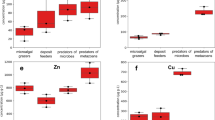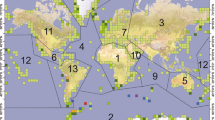Abstract
LARGE quantities of seaweeds (kelp) are washed ashore along the coasts of California. Estimates range from 104 to 106 tonnes (107–109 kg) wet weight per yr. These algal masses provide food for insects and other invertebrates on the beaches. The plants carry with them a variety of di-, tri-, and polyvalent cations of heavy metals, largely adsorbed or chelated to superficial acidic polysac-charides and surface slimes of bacterial origin. Among the heavy metals one can detect small amounts of radioactive elements, including some that emit high-energy α particles such as the natural polonium (210Pu, half life 138 d) and the artificial plutonium nuclides (239,240Pu, half lives 24,360 yr and 6,580 yr respectively)1. In surface waters of the oceans, polonium is born from the decay of 210Pb which is continuously replenished by decay of radon released from the Earth's crust. The plutonium isotopes occur in ocean waters as a consequence of fallout from atomic test explosions some 15–20 yr ago. We have examined the extent to which these elements may be transferred from the ocean to the terrestrial biosphere by means of kelp, kelp flies and their predators. Fears have been expressed that radioactivity from the algae could be reaching man through the terrestrial food chain. Our investigations suggest that, on the basis of current radiation thresholds for human healthand safety, such fears are groundless.
This is a preview of subscription content, access via your institution
Access options
Subscribe to this journal
Receive 51 print issues and online access
$199.00 per year
only $3.90 per issue
Buy this article
- Purchase on Springer Link
- Instant access to full article PDF
Prices may be subject to local taxes which are calculated during checkout
Similar content being viewed by others
References
Hodge, V. F., Hoffman, F. L. & Folsom, T. R. Health Phys. 27, 29 (1974).
Wong, K. M., Hodge, V. F. & Folsom, T. R. Nature 237, 460 (1972).
ZoBell, C. E. Nova Hedwigia 32, 269 (1971).
Dobson, T. in Marine Insects (ed. Cheng, L.) 447 (North-Holland, Amsterdam, 1976).
Oldroyd, H. Discovery 15, 198 (1954).
Author information
Authors and Affiliations
Rights and permissions
About this article
Cite this article
CHENG, L., HODGE, V. & LEWIN, R. Polonium and plutonium in an intertidal food chain. Nature 269, 795–796 (1977). https://doi.org/10.1038/269795a0
Received:
Accepted:
Issue Date:
DOI: https://doi.org/10.1038/269795a0
Comments
By submitting a comment you agree to abide by our Terms and Community Guidelines. If you find something abusive or that does not comply with our terms or guidelines please flag it as inappropriate.



